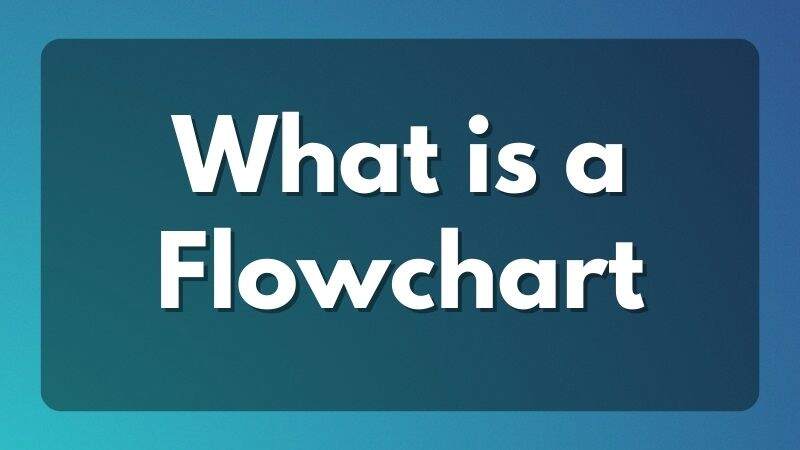A flowchart is a diagram that shows the actions, choices, and sequences of a workflow or process. An elementary flow chart is the most basic type of a process map, even though there are many distinct forms of flowcharts.
In programming, a flow chart represents the graphical form of an algorithm. It is a potent tool that may be applied to many different fields for process planning, visualization, documentation, and improvement.
Rectangles, ovals, diamonds, and possibly many other shapes are used in flow charts to indicate the type of step and connecting arrows to indicate flow and sequence. They might be anything from straightforward hand-drawn charts to detailed computer-drawn diagrams showing numerous processes and pathways.
Uses of a Flowchart
Overall, it helps anyone to easily understand complex processes. Following are some of the reasons for using flowcharts in your work:
- It lets you gain knowledge of how a process is carried out.
- Using a flowchart might help you find difficulties or bottlenecks before they become full-fledged problems.
- It is an excellent option to record a procedure.
- It helps in explaining how code is arranged while designing a project.
- You can easily imagine how a program’s code might run if you could see it.
- It describes how a website or application is organized.
- You can effectively recognize how users move throughout an application or website.
- You may find it simpler to allocate responsibilities to team members and arrange your team’s work so that everything flows more smoothly if you portray a process visually.
Symbols Used in a Flowchart
Following are some of the common symbols that are used for drawing typical flow charts:
1. Terminator

Fig. i – A rounded rectangle
The terminator, often known as the oval, is used to indicate the beginning and finish of a procedure. You can start a flow chart by dragging and dropping one of these bad boys into the Gliffy flowchart tool. Use the same symbol once again to indicate that your flowchart is finished.
2. Process

Fig. ii – A rectangle
Once you begin flowcharting, the rectangle is your default symbol. It is the workhorse of the flowchart design and represents any stage in the process you are illustrating. Use rectangles to describe process steps in your process, such as fundamental tasks or actions.
3. Input/Output

Fig. iii – A parallelogram
The inputs and outputs are entered into a parallelogram-shaped box. The information entering the system or algorithm and information leaving the system or algorithm is essentially depicted like this.
4. Arrow

Fig. iv – An arrow
The arrow directs the viewer along their intended path. While there are many different arrow tip styles available, we advise sticking to one or two for the duration of your flow chart. This allows you to highlight specific steps in your process while keeping your diagram looking tidy.
5. On-page Reference

Fig. v – A circle
The circle symbol shows that the flowchart is continuing with additional phases. When there is little room and a lengthy flow chart, this figure is used.
To help the user comprehend the continuation, the identical numerical sign that is present inside this circle will be shown before it.
6. Decision

Fig. vi – A square
Control statements like if and conditions like a > 0, etc., are written inside this rhombus-shaped box. There are two routes from this one, one of which leads to “yes,” and the other one leads to “no.”
Similar to how there are just two alternatives for every decision—yes or no—these are the options for this box.
7. Document

Fig. vii – A square-like figure
Icons for single and multiple documents indicate that your flowchart contains extra points of reference. These could be used to denote actions like “generating an invoice” or “examining test documentation.”
Example of a Typical Flowchart
The following figure demonstrates a typical flowchart:

Fig. viii – A typical flowchart
Types of Flowcharts
1. Data Flowcharts
As the name implies, these are used to evaluate data, and more specifically, they aid in the analysis of project-related structural information.
Data flow charts make it simple to comprehend how data enters and leaves the system. Most frequently, it is utilized to manage data or evaluate information moving in and out of the system.
2. Document Flowcharts
These seek to demonstrate current controls over document flow through system components. These flowcharts show how papers move through different business units and are read from left to right.
3. Process Flowcharts
These show how a procedure will produce a particular result. A process flow chart will probably be made by you to develop a new process or to enhance an existing one. A swimlane diagram serves as an illustration of a process flowchart.
4. System Flowcharts
These display the flow of data to and through the primary components of a system, such as data entry, programs, storage media, processors, and communication networks.
5. Business Process Modeling Diagrams
Using a flowchart or diagram to describe the business process analytically makes it easier to comprehend how business operations and information flow.
These flow charts graphically represent the business process and open the way for process improvement.
6. Logic Flowcharts
These are used to find gaps, obstructions, or restrictions in the procedure that could result in problems or disruptions.
Conclusion
In this blog, we came across the basics of flow charts that could be useful in your daily tasks. A flow chart is the easiest way to understand the complex process, structures, and designs.
Flow charts act as translators for you with which you can understand how an algorithm will solve a specific coding problem.

I have 9+ years of experience in writing content in both full-time and freelance capacities and 1.5+ years of experience in content editing and management. I’m well-versed in handling teams of 25+ professionals in on-site, remote, and mixed settings. I have worked for leading blogs like hackr.io, InterviewBit, Intellipaat, and KnowledgeHut.

